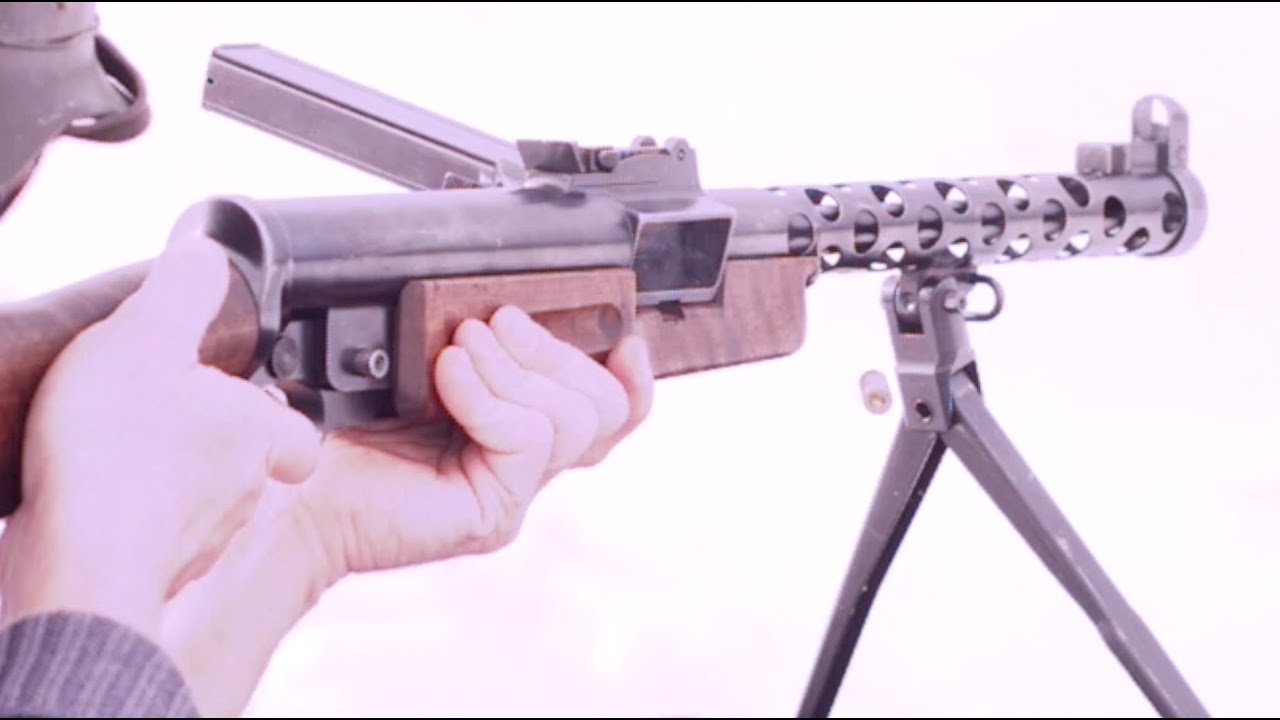yes, it has a side magazine (which was the style at the time  ), although it's at a bit of an angle, slightly diagonal
), although it's at a bit of an angle, slightly diagonal

yes, it has a side magazine (which was the style at the time  ), although it's at a bit of an angle, slightly diagonal
), although it's at a bit of an angle, slightly diagonal

yeah, Dresden goes to the CPC and Munich and its environs (most of Southern Bavaria, really) goes to the KMT, for... some reason
honestly, he should have gone full hog and given them neighboring regions so the resumed Chinese Civil War can be fought on German territory
HoI4 peace conference ass map
I like that there's both a Chinese Nationalist and Chinese Communist zone, truly 
by the magazine, but it'd definitely be very awkward - you can't really wrap your hand around that, I guess you'd need to basically have your thumb sort of resting along the side, which probably isn't going to be very comfortable, especially with the weird angle your hand would have to be sitting in

(on this C96 Mauser that grip is used to avoid having the hammer smack right into the webbing of your hand, which is occasionally a problem on some pistols, but particularly on the Mauser with the stock attached)

accidentally subscribing to Ancient Egyptian beliefs about the heart
The heart was regarded in Ancient Egypt as the organic motor of the body and also the seat of intelligence, an important religious and spiritual symbol. It was considered as one of the eight parts of human body. Counter to other organs it had to be kept carefully intact in the mummy to ensure its eternal life. In Ancient Egypt, the concept of heart included three constituents: heart-haty, heart-ib, and the spiritual seat of intelligence, emotion and memory.
(why yes, I did watch a ton of the Tutenstein cartoon as a kid, how could you tell?  )
)
https://xcancel.com/JesseJenkins/status/1840773225070158215
critical support to the US in reducing carbon emissions by de-electrifying itself

gommunism no food? capitalism no power!

https://xcancel.com/ArmchairW/status/1839453350854853047
There's actually a critical lesson to draw from this and other Ukrainian fiascos, of which the Bakhmut saga and the Zaporozhie Hundred Days come to mind: Ukraine will have ended up losing this war in large part because it consistently tried to fight beyond its means.
The Ukrainians started this war with an enormous army, well in excess of what the Russians could and actually did commit to the fight in 2022. That huge force (the "First Army") was badly mauled in early 2022, but it was rejuvenated later that year by a combination of ruthless mobilization and massive aid from NATO. This convinced the Russian Stavka to transition to the defensive and consolidate their position in Ukraine, withdrawing troops from more exposed positions in east Kharkov and right-bank Kherson. Any serious assessment of the situation at that point would have been that the Russians had consolidated into a basically impregnable position that the AFU was incapable of breaching (lest we forget in the wake of Russia's totally unhindered withdrawal from the area, their attempts at reducing the Kherson bridgehead by force in mid-2022 were bloody disasters), and the correct course of action was to start digging in and negotiate a peace treaty in the meantime.
The Ukrainian leadership instead threw a disturbingly large portion of the "Second Army" into Prigozhin's meatgrinder in Bakhmut and then ordered not one but two large-scale counteroffensives into Zaporozhie and the Bakhmut flanks using the post-Bakhmut remains of the "Second Army" and their NATO-supplied "Third Army." Those failed with enormous losses, opening the way for Russia to transition back to the offensive in late 2023 and begin systematically rolling Ukraine out of the Donbass. The correct course of action at this point was, again, to find a tenable defensive line and start digging. Zelensky instead ordered a "Hail Mary" offensive in Kursk with the remnants of the "Third Army" and significant elements from a lightly-equipped "Fourth Army," hoping Russian border defenses were weak despite their having ample warning of Ukrainian designs on the border region (courtesy of several earlier, smaller raids) and plenty of time to prepare. It proceeded to fail with enormous losses - Ukrainian forces breached the border, began to exploit, and ran square into a Russian haymaker counter-punch that stopped them in their tracks. The Ukrainians then reinforced failure, sending massive reinforcements into a death pit in an attempt to keep a sliver of Russian soil under their flag as a middle finger to Putin.
And while this was happening the front in the Donbass started to collapse with Russian troops making large advances and seizing key terrain, in no small part because the AFU's resources had been systematically redirected to a tertiary operation far to the north. We've seen, again and again and again, that when the Ukrainians got resources and generated forces, rather than admitting they are the weaker power here and working to strengthen their positions and conciliate, they instead squandered them on hugely ambitious and equally doomed offensives. In 2023 these offensives were aimed at restoring their pre-2014 borders when Donetsk may as well have been on the Moon for them, while in 2024 their ambitions transitioned to the outright insanity of conquering southwest Russia despite the fact they'd been on the military back foot for the last year. These are the moves of a power setting objectives beyond its means to achieve, and they will probably end up dooming Ukraine as a sovereign state going forward.
https://xcancel.com/maphumanintent/status/1720933055307600231
Fun theoretical exercise I'm currently working on for the @fortisanalysis side of things:
US refineries (total) only store about 40 million gallons of military-grade jet fuel at any given time, or about 36,400 flight hours for an F/A-18E/F Super Hornet launched from an aircraft carrier. For 40 x -18's per carrier, this is about 910 flight hours. A carrier holds roughly 3 million gallons of fuel for its wing, about 68 flight hours per bird. Now consider that a notional mixed complement of 20 x F-35's and 20 X F-15EX's operating out of Kadena AFB would consume about 62,400 gallons per hour combined. Thus, just a single carrier wing and a single AFB wing's complement of fighters (80 combined) theoretically all operating at once would drink 106,400 gal/hr.
So...
The net stores of military jet fuel immediately available from US refiners above the global contingency supplies managed by the Defense Logistics Agency at any time represents about 375 net flight hours for one carrier and one air wing...less than 16 days of high intensity air operations by far fewer assets than the US would throw into an all-out theater conflict in the Pacific Rim. DLA Energy ended FY2022 with 1.68 billion gallons of on hand inventory of jet fuel to serve the entire DOD combined inventory of 14,000+ aviation assets - cargo, fighter, rotary wing, bombers, drones, tankers, and recon. Which begs the question: How fast would two theaters of conflict burn through all contingency supplies of fuel? And what does DOD do when the well runs dry?
Reminder that for the Gulf War's air campaign, the US had nearly 6 months to prepare, move assets into place, build up whole new infrastructure, etc., right next to Iraq without the Iraqis being able to do much to respond. Westerners love to call back on that campaign to justify their belief that the US/NATO could totally destroy any opponent in just a few weeks with their superior air forces, but completely ignore the logistical realities of actually doing so. And today, with the proliferation of long-range precision munitions, actually managing to build up the concentrations of forces and supplies necessary for large campaigns like this is substantially more difficult - we see this already in Ukraine, with Russian deep strikes doing significant damage, taking out ammunition depots and arms shipments, and wiping out various gatherings of Ukrainian troops and mercenaries.
If Iraq had the ballistic missiles that Yemen wields today, things could have gone very differently back then.
an uneasy feeling but nothing specific to complain about
vibes-based performance evaluation
twitter thread (nitter alt) about the deteriorating US situation in the Middle East
They all think it's still 2003, with no notion of constraints, nor any respect for or even knowledge of the US' enemies. ... The Iraqis are at the heart of this crisis, and nobody in the official US sphere is talking about it openly. Every "retaliation" for Iraqi attacks on US bases is taking place in... Syria. Now why is that? Is it because the US doesn't care about Iraq and just wants an excuse to go after Assad again? No. Blinken flew under the cover of night into Baghdad, wearing a fucking flak vest, specifically to try to convince the Iraqi government to do something to stop all these attacks!
The reason the US is attacking "Iranian" warehouses in Syria to deter attacks by Iraqis - without EVER mentioning them by name - is because the US deep state is scared shitless of an Iraqi quagmire. The Iraqis go out and officially declare war on US. The US response? Silence. There's constantly escalating attacks inside Iraq. Rockets, drones, now IEDs against US convoys. The Iraqis are totally open about this, they're saying in public "we're at war with the US! We're gonna kick them out!" and Lloyd Austin goes up and pretends these Iraqis don't exist!
... a core feature of the US army today is that it is basically close to unusable, de facto. The US Army has a couple of massive problems right now: first, it's got a HUGE manpower deficit, especially in combat arms. Second, it can't really move very easily! Moving an army corps is a lot of work: it requires a lot of airlift, or - more preferrable - sealift. But US sealift capacity has atrophied immensely since the 90s. Getting an US armor division to Iraq today is a lot more difficult than it once was, due to lowered capacity.
I don't want to dive too deeply into army-specific problems in this thread, so I'll just get to the upshot: the US doesn't have enough men to really put "boots on the ground" in a serious conflict, nor the transport capacity to do so. It's not just a lack of political will. ... the US is basically down to a small garrison presence. You can back that up with air power, but on the ground, the US posture is a few islands of hundreds or thousands of Americans... in a sea of hostile arabs. These arabs have modern small arms. Some of them have night-vision equipment. But most of all, they have heavy stand-off weaponry: Burkan ("Volcano") rockets, used to great effect in Syria, Iranian suicide drones, cruise missiles, ballistic missiles, and iranian SAMs.
To further complicate the fairly terrible ground situation, American airpower in the region is very vulnerable. Most Americans still think they have this factory-fresh, high tech air force, but that's not been the case for decades. The workhorses - F16, F15, F-18 - are ancient ... the same kinds of planes used by Saudi Arabia against Yemen. And the Houthis have shot down a lot of Saudi jets. So even the Yemenis - the second most poor country in the region - can now realistically challenge US airpower, using iranian-made SAMs. Today, America has neither the fiscal space or the productive capacity to really deal with airframe attrition ... US bases in the region can now be attacked by stand-off weaponry, and it's long been a known problem that the USAF has never seriously adapted to the idea that airfields can simply be contested by enemy stand-off weaponry from afar. F-35 stealth doesn't work on the ground. ... the entire dynamic of the US actually using airpower in the region has now potentially changed, and changed in a very ominous, depressing way. Carriers can now be hit by anti-ship cruise missiles and drones, which are becoming widely available in the region. Are they guaranteed to work? No. But they're not guaranteed to fail either. Airbases can be hit with cruise missiles and drones; just ask the Americans at Al-Harir!
All of this means that Lloyd Austin at the Pentagon and Tony Blinken at State are in a very, very shitty position right now, to say the least. The openly declared war against the US in Iraq is basically being shoved under the rug, because the US can't afford to admit it exists! To uninformed Americans, the US is still a completely dominant, invincible force. America only loses because it gives up; its planes are invincible, its technology supreme, its forces, untouchable. But this fantasy is a product of the US military's isolation from civilian life. For people inside the military, the view is very different ... Thus, if Lloyd Austin goes up there and says "okay, the Iraqis are attacking us now", he is going to be inundated with calls from moronic GOP politicians and uninformed US civilians to "unleash the American magic!!!" or "teach the arabs why we don't have healthcare lol!!!".
But in reality, that moment in time has passed, and it's not coming back. If Austin goes up there and admits that, admits that the US is now severely limited in what it can do and how much it can fight, he'll lose his job. What's worse, the US will lose imperial prestige! That prestige is fantastically important, for many reasons. Partly, it serves as deterrence against people picking further fights with the US. Partly, it makes the current - completely unsustainable - budget deficits somewhat manageable in the short term. I could go on, but I hope I've made my point by now. The Iraqis are, as the American saying goes, pissing all over the American pant-leg right now. The Iraqis themselves are saying "we're pissing on you, America!", but America is forced to say "No no no, it's just raining!"
It's perhaps somewhat exaggerating how bad things really are, but there's still a lot of interesting points, especially the stuff about air power. Back in the olden days, you did need to actually fly your own planes over the enemy airbases to disable them, but this is no longer the case thanks to advances in missile technology, and the proliferation of cheap missiles among even militia groups means that forces which normally couldn't maintain their own airforce can now still manage to strike at far-away targets, and do so with munitions significantly cheaper than what they'll be destroying. And of course, there's the important logistical reality that Western commentators systematically ignore - how capable is the US, really, at deploying a large ground force, and doing so quickly? Not supplying another military, not flying around and bombing the occasional target, not sending in some special forces team to do a raid, but a proper army corps, of several divisions, the way they were once able to do in Iraq? Even back then, there was still a lot of preparation involved, the invading force didn't just materialize in Kuwait one day, so how capable of repeating that would they be now?
genocide is when there's camps
Uyghurs? well, there's camps, so it's genocide
dropping over half a million tons of bombs, deliberately targeting civilian infrastructure until you've basically razed the entire country to the ground and bomber pilots end up just dropping their payloads on random fields since there literally isn't anything left to bomb? no camps, so it's all fine, just a bit of collateral damage
I think sometimes it's done for legal reasons (rifles below a certain barrel length in the US are special and need some extra permits, but permanently attaching some kind of muzzle device counts as increasing the barrel length, and using a dummy suppressor specifically can get you the aesthetic of suppressed compact carbines like the AKS-74U or CQBR without the legal hurdles), but in this case it might not be that, since the M1 Carbine already has a sufficiently long barrel. The page I got it from states it might be a movie prop or display item.
https://www.wargm.org/armoury/index.php?mode=2&cat=Fully+Automatic+and+Self+Loading+Rifles+and+Carbines&item=125